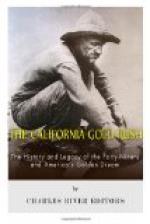This confusion, of course, was worse at the beginning. Later the journey was to some extent systematized. The Panama route subsequently became the usual and fashionable way to travel. The ship companies learned how to handle and treat their patrons. In fact, it was said that every jewelry shop in San Francisco carried a large stock of fancy silver speaking-trumpets because of the almost invariable habit of presenting one of these to the captain of the ship by his grateful passengers. One captain swore that he possessed eighteen of them!
CHAPTER VIII
THE DIGGINGS
The two streams of immigrants, by sea and overland, thus differed, on the average, in kind. They also landed in the country at different points. The overlanders were generally absorbed before they reached San Francisco. They arrived first at Fort Sutter, whence they distributed themselves; or perhaps they even stopped at one or another of the diggings on their way in.
Of those coming by sea all landed at San Francisco. A certain proportion of the younger and more enthusiastic set out for the mines, but only after a few days had given them experience of the new city and had impressed them with at least a subconscious idea of opportunity. Another certain proportion, however, remained in San Francisco without attempting the mines. These were either men who were discouraged by pessimistic tales, men who had sickened of the fever, or more often men who were attracted by the big opportunities for wealth which the city then afforded. Thus at once we have two different types to consider, the miner and the San Franciscan.
The mines were worked mostly by young men. They journeyed up to the present Sacramento either by river-boats or afoot. Thence they took their outfits into the diggings. It must have seemed a good deal like a picnic. The goal was near; rosy hope had expanded to fill the horizon; breathless anticipation pervaded them—a good deal like a hunting-party starting off in the freshness of the dawn.
The diggings were generally found at the bottoms of the deep river-beds and ravines. Since trails, in order to avoid freshets and too many crossings of the water-courses, took the higher shoulder of the hill, the newcomer ordinarily looked down upon his first glimpse of the mines. The sight must have been busy and animated. The miners dressed in bright-colored garments, and dug themselves in only to the waist or at most to the shoulders before striking bed rock, so that they were visible as spots of gaudy color. The camps were placed on the hillsides or little open flats, and occasionally were set in the bed of a river. They were composed of tents, and of rough log or bark structures.




